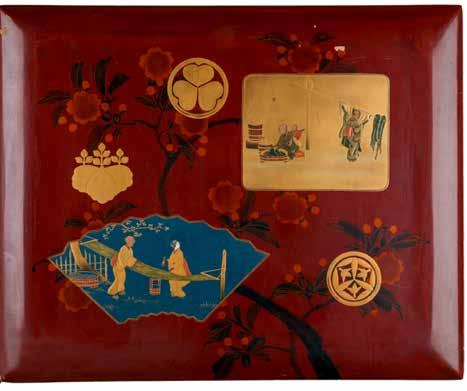The quest for beauty amidst the ashes: the creation of samurai culture
Russell Kelty The world is all a dream, and he who wakes the world is all a dream, and he wakes, casting it from him, may yet know the real. (The monk Rensho, formerly the Minamoto warrior Kumagai, from the Nō play, Atsumori)
In a small mountain retreat nestled in the eastern hills of Kyoto, a failed shogun’s passion for the arts inspired a renaissance amidst the chaos of war. As the power of regional daimyo expanded and the shogunate faltered, Ashikaga Yoshimasa (1436–1490) surrounded himself with the foremost Nō playwrights, tea masters and gardeners, and in his Silver Pavilion experimented with new types of interior architecture and displays. He was an artistic connoisseur of rare sensitivity and the culture which blossomed under his guidance and patronage shaped the tastes and pursuits of future shogun, daimyo and samurai. The new aesthetic was defined as mysterious and tinged with a recognition of impermanence and has been described as the ‘the soul of Japan’.1 The calamitous historical events that inspired The Tale of the Heike ushered in the era of the samurai and the decline of the influence of the aristocracy in Kyoto. The victorious leader, Minamoto no Yoritomo (1147– 1199), established Japan’s first warrior government (bakufu) in Kamakura on the east coast of Japan and assumed the title of shogun, the Emperor’s military commander. For the next 600 years the archipelago was ruled and administered by a succession of hereditary military governments, which recognised the legitimacy of the Emperor. Over time, the bakufu in Kamakura established offices in Kyoto and wielded such considerable influence that they were able to select emperors, control imperial appointments and maintain control over the regional provinces.2 The first code of the samurai was written to deal with disputes over land and religious and criminal disputes (joei shikimoku) and recognised the separate function of the imperial court.3 The new military ethos, described as ‘violent and masculine’ (masuraoburi), contrasted with the ‘gentle and feminine’ (taoyameburi) culture of the Kyoto aristocracy.4 However, the military elite indulged in the pursuits of the court and were ‘more likely to compose poetry on the beauty of falling cherry blossoms than on the joys of victory in battle’.5 The literature of the period reflected the interests of the samurai and was infused with a sense of pessimism and a recognition of impermanence, encapsulated in the widespread belief that Japanese society had entered a degenerate age of Buddhism (mappō) and had narrowly escaped the Mongol hordes who were turned away by divine winds (kamikaze).6 18
1 Donald Keene, Yoshimasa and the silver pavilion: the creation of the soul of Japan, Columbia University Press, New York, 2003. 2 Seiitaishogun (Supreme commander against the barbarians), shogun, is the term most commonly used to refer to the heads of three samurai governments (‘shogunates’ or bakufu) which ruled Japan 1192–1333, 1336–1573, 1615–1868. 3 John Stevenson, ‘The warrior in Japanese history’, in J. Gabriel Barbier-Mueller (ed.), Art of armor: Samurai armor from the Ann and Gabriel BarbierMueller Collection, Yale University Press, New Haven, 2011, p. 35. 4 Stevenson, p. 36. 5 Ryusaku Tsunoda, W.T. De Bary & D. Keene, Sources of the Japanese tradition, Columbia University Press, New York, 2001, p. 364. 6 According to Buddhist beliefs, the period following the death of the historical Buddha is divided into three ages and mappō is the last and final age, which began in 1052 CE and will end with the arrival of the buddha-to-be, who will restore the dharma.

















